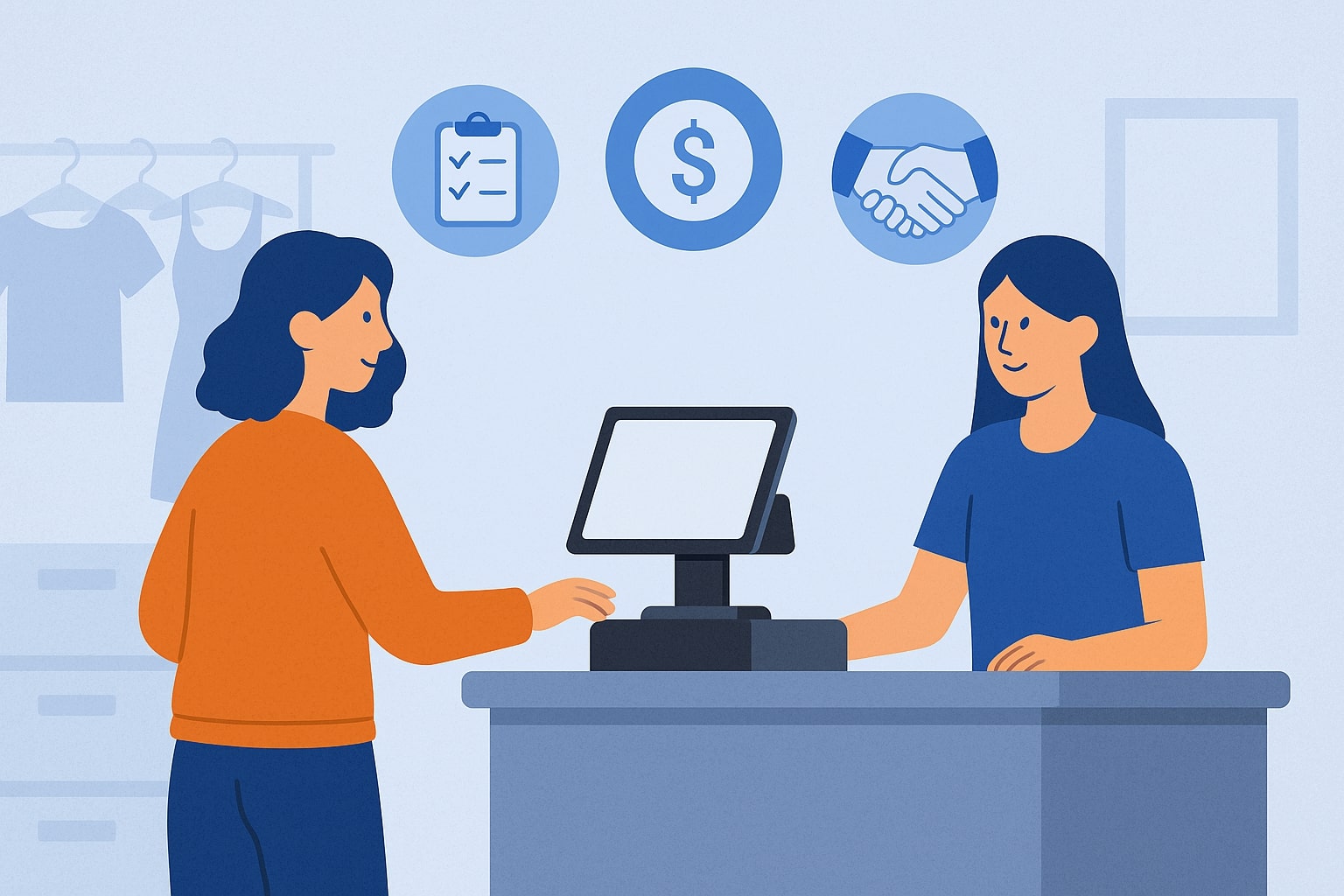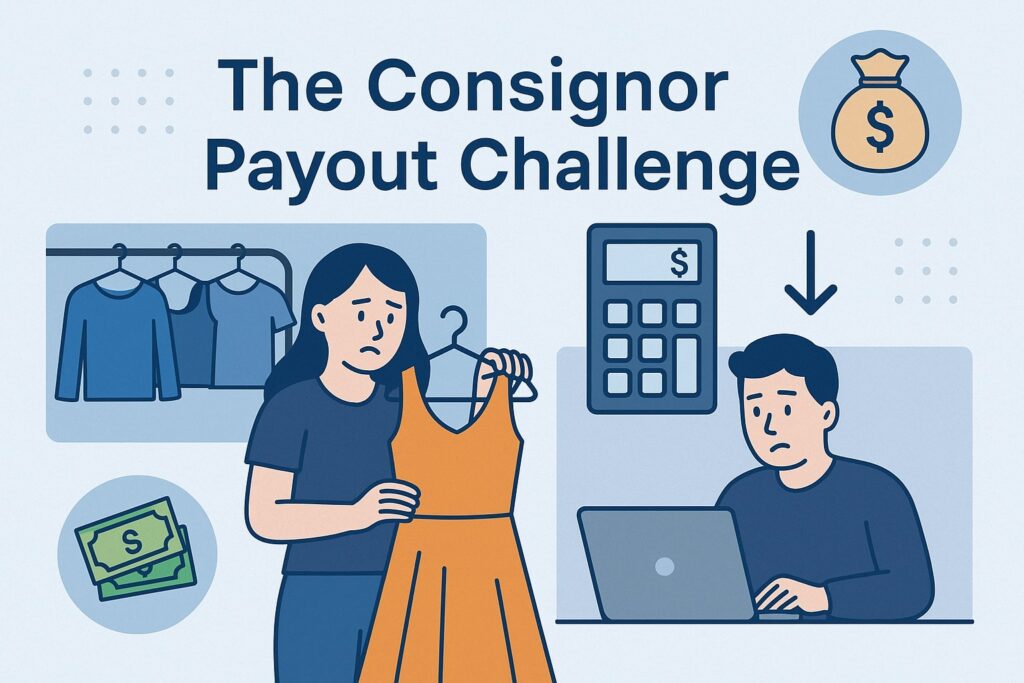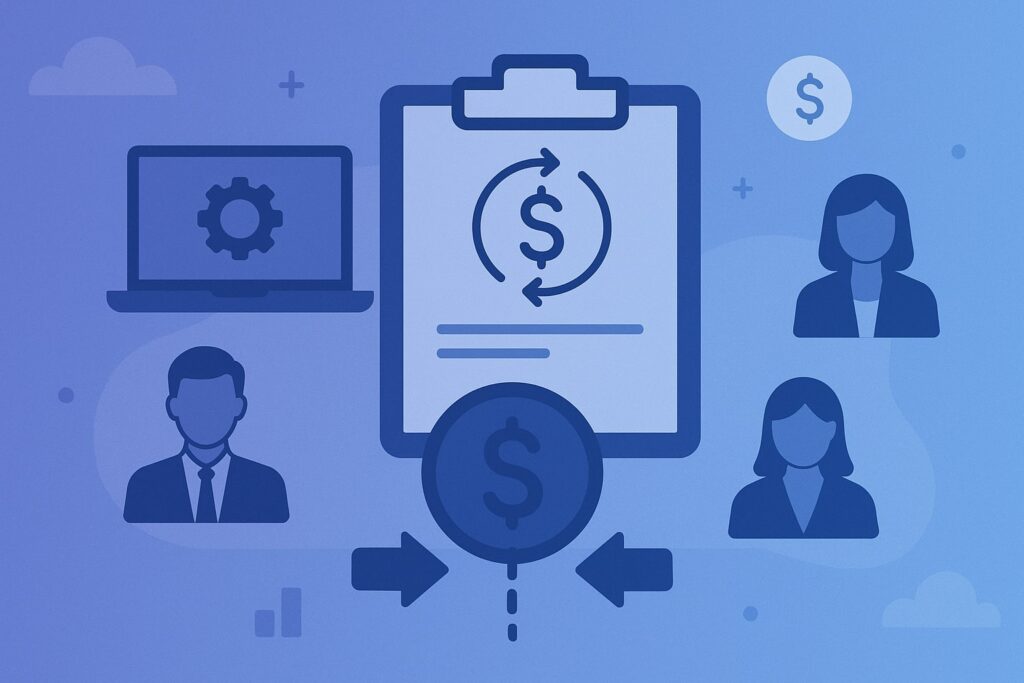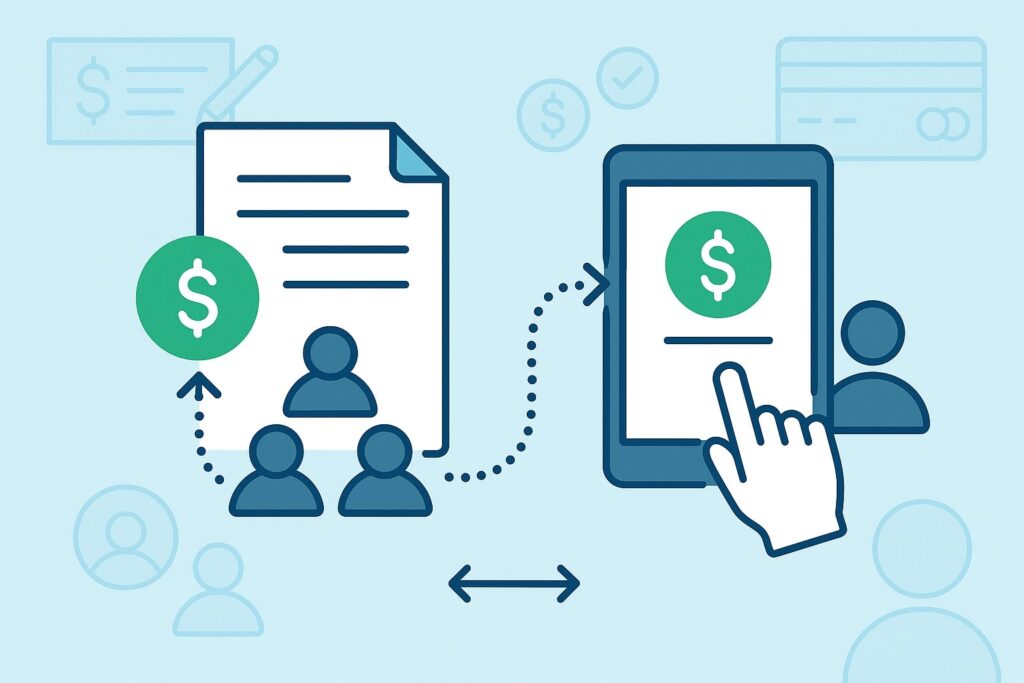
By consignmentpos September 13, 2025
Consignment shops sell goods on behalf of individual consignors and split each sale according to agreed commissions. A consignment POS (point-of-sale) is specialized software for this model. It tracks every item by consignor, applies preset commission rules, and automates the payout process.
Unlike a generic cash register, a consignment POS handles unique tasks like assigning barcodes to consigned items and crediting the correct person on each sale. By design, these systems simplify accounting and reduce manual errors, so store owners save time and consignors get paid accurately.
The Consignor Payout Challenge

Before using a consignment POS, shops often rely on paper logs or spreadsheets to track sales. This is error-prone and slow. Without automation, owners must calculate each consignor’s share by hand and cut individual checks or issue store credit one by one.
Common pitfalls include miscalculating percentages and writing checks for every consignor – a process so laborious that mistakes are almost inevitable. Slow or inaccurate payments frustrate consignors and “can quickly erode trust,” as experts warn.
In short, manual payouts waste time, introduce errors, and make consignors feel kept in the dark.
- Manual Calculations: Spreadsheet or handwritten logs invite math mistakes that lead to over- or underpaying sellers.
- Labor-Intensive Payments: Writing checks one at a time is slow and burdens staff.
- Poor Transparency: Without instant records, consignors can’t easily verify sales or balances, sowing doubt.
These issues add up. Store owners and consignors both suffer when payouts are slow or incorrect, which is why many shops now turn to a dedicated consignment POS solution.
Automated Commission Splits

A core benefit of consignment POS software is automatic commission calculations. When you enter a new item, the system assigns it to a consignor’s account and records the agreed split. Then, whenever that item sells, the POS instantly applies the percentage (for example, 40%) to compute the consignor’s share. This eliminates manual math.
For example, ringing up a $50 sale with a 50/50 split immediately credits $25 to the consignor’s ledger. Stores can even set tiered or category-based splits (e.g. higher percentage for expensive items) so every scenario is handled correctly.
By automating these rules, a consignment POS ensures accuracy and consistency in every transaction, freeing owners from error-prone calculations.
- Instant Splits: Each sale triggers an automatic commission credit, calculated by the software.
- Flexible Rates: You can configure different commission levels for various item types or price ranges.
- Error Reduction: The POS logs every sale in consignor accounts, so you avoid miscalculations and keep reliable records.
Batch Payouts and Direct Payments

Consignment POS systems also streamline the actual payout step. Instead of preparing one check per consignor, you can batch process all payments at once. At a chosen interval (weekly, monthly, etc.), the POS can compile a list of all consignors with balances due.
Then it produces checks or store credit slips for each in one operation, or even triggers direct deposits/ACH transfers with a few clicks. This saves hours of work and cuts paper handling. Some systems integrate with banking or accounting software, so payments are sent automatically and recorded for you.
As one report notes, “automatic tracking and payout detection ensures sellers get paid the right amount, every time,” with no manual computation.
In practice, batch payouts mean on payday your staff clicks a button instead of crunching numbers – consignors receive their rightful earnings accurately and promptly.
- One-Click Payments: Filter to all consignors owed money and pay them in a single batch operation.
- Flexible Methods: POS can print bulk checks, apply store credit, or initiate ACH/Direct Deposit to consignors’ bank accounts.
- Reduced Errors: Automating payouts cuts manual math and paper trails, virtually eliminating under- or over-payments.
Consignor Portals and Transparency
Building trust means giving consignors visibility into their accounts. Many consignment POS solutions include a self-service portal or app. Through this portal, consignors can log in 24/7 to see exactly which of their items are in stock, which have sold (and for how much), and what their current payout balance is.
They might even add item descriptions or check status notifications remotely. This level of transparency is a game-changer: consignors no longer need to call the store for updates. Instead, they instantly see their sales and earnings for themselves.
Portals significantly reduce confusion and disputes. Industry guides emphasize that “efficient consignor management builds trust”, and real-time access to sales data is a big part of that. Consignors feel confident when they can verify every sale and balance on demand.
For the shop, fewer questions and complaints come in, freeing staff to focus on other tasks. In short, consignor portals provide transparency – when sellers see the system keeping perfect records, their confidence in the store’s honesty soars.
- Account Dashboards: Portals let consignors view item lists, sales history, and pending earnings in real time.
- Sales Notifications: Some POS can push alerts (email/text) the instant one of their items sells, so they’re always in the loop.
- Self-Service Tools: Via the portal, consignors can also notify you of new items they want to consign, or see upcoming markdowns.
Notifications and Communication
Clear communication is another trust-builder that modern POS systems offer. Once a system records a sale, it can automatically notify the consignor – for example, sending an email or SMS message like “Your item X sold for $Y; $Z has been added to your account”.
Similarly, when payouts are processed, the system can alert consignors that their payments have been sent. These automatic updates keep consignors engaged and reassured without extra work from you.
As one POS provider explains, simple messages ensure consignors “are kept informed without any manual effort”. In practice, automatic notifications mean consignors rarely wonder about their sales – they see it happen in real time and receive proof of payment soon after.
This proactive communication strengthens relationships by showing you value the consignor’s time and contributions.
- Sale Alerts: Instantly inform consignors when an item sells, with details of the price and their share.
- Payment Notices: Automatically email consignors when a payout has been issued, eliminating surprises or confusion.
- Regular Reminders: The POS can also schedule polite reminders about unsold inventory approaching expiration or upcoming markdowns.
Inventory Accuracy and Tagging
Accurate inventory tracking underpins reliable payouts. A consignment POS handles real-time tagging and tracking of every item, usually with barcodes. When you check in new inventory, the POS prints a unique barcode tag linked to the consignor’s account.
Staff scan those tags at checkout, automatically marking the item as sold and attributing the sale to the correct person. This automation prevents mix-ups.
For example, without barcoding it’s easy for tags to get lost or misread, which could make it impossible to know who to pay when the item sells – leading to “lost revenue and unhappy consignors”.
With POS-enabled scanning, double-selling (selling an item that’s already gone) is virtually eliminated, and stock records stay accurate in real time. According to industry reports, automated tracking “avoids common problems such as overselling, lost items, delayed payouts, and incorrect counts”.
In other words, by keeping an exact digital ledger of items and their status, a consignment POS ensures the system always “knows exactly what [you] have in store”.
This accuracy not only speeds up checkout, but also means consignors are only credited for actual sales and never left wondering “where’s my payment?” due to a tracking error.
Modern POS software tags and tracks every consigned item. Barcodes and scanning ensure that when an item sells, the system automatically updates stock and assigns the sale to the correct consignor.
- Barcode Scanning: Items get a unique barcode at intake, so scanning at sale instantly links it to a consignor’s account.
- Error Prevention: Real-time inventory updates prevent mistakes like selling the same item twice or mis-attributing a sale.
- Multi-Location Sync: If you have more than one store, POS can show a unified inventory so you don’t accidentally double-sell an item in different locations.
Reporting, Accounting, and Insights
A consignment POS also acts as your record-keeper and analytics tool. You can generate detailed payout reports for every consignor – summaries that list all the items sold in a period and the total owed.
Many shops share these statements as a courtesy, and modern systems can produce them in batch rather than by hand. This visibility again builds trust: consignors see exactly what they sold and what they’ll be paid.
On the accounting side, good POS solutions integrate with finance software. For instance, many support QuickBooks or similar platforms, syncing daily sales and payout data automatically. This means you don’t have to re-enter transactions or worry about tax reporting; the POS keeps bookkeeping accurate and hassle-free.
Beyond payouts, a cloud-based POS provides real-time dashboards and analytics. You can track overall sales, identify top-selling consignors or product categories, and monitor inventory age at a glance.
These insights let you optimize the business. For example, if reports show a consignor’s items consistently sell well, you might encourage them to bring more, or adjust pricing strategies for slower items. In short, a POS turns raw data into actionable intelligence.
As one guide summarizes, powerful reporting built into a consignment system gives even a small shop “a full analytics department”, helping owners make informed decisions and demonstrating professionalism to consignors.
- Consignor Statements: Batch-generate clear statements for each consignor, detailing items sold and payouts due.
- Accounting Sync: Integrations (e.g. QuickBooks) automatically import sales and commission totals for smooth bookkeeping.
- Sales Insights: Track trends and performance (top sellers, best months, aging stock) with built-in reports to improve profits.
Key Features to Look For
When evaluating a consignment POS, focus on features that directly support payouts and transparency. Industry experts advise ensuring the software includes robust inventory tagging (barcodes) and a consignor account manager.
It should let you flexibly set commission splits and automatically apply them at checkout. A cloud-based system is ideal, offering secure backups and 24/7 access from any device – so you can update records remotely and consignors can log in from home.
Also look for integrated payment processing (so the POS itself accepts cards) and a user-friendly consignor portal.
In summary, the must-have toolbox includes real-time tracking, automated commission calculations, batch payout capability, transparent dashboards, and online portals for consignors. Together, these ensure payouts are timely and error-free, and consignors feel respected. A table of feature benefits might look like:
| Consignment POS Feature | Benefit for Payouts and Trust |
|---|---|
| Automated Commission Splits | Ensures exact sales splits and eliminates manual math. |
| Batch Payout Processing | Pays all consignors at once (via check, ACH, etc.) saving hours. |
| Self-Service Consignor Portal | Let sellers view sales and balances anytime, building confidence. |
| Automated Notifications | Instantly informs consignors about sales and payouts. |
| Detailed Reporting & Sync | Generates clear payout statements and syncs with accounting. |
Each of these features addresses a pain point of manual payouts. Together they build a more efficient, transparent process.
Building Consignor Trust
At its core, a consignment POS builds trust by eliminating doubt. When every sale and commission is recorded automatically, consignors can be confident their earnings are accurate. If questions arise, the data is there to prove it.
Transparent portals and reports mean consignors no longer wonder “Did the store mess up my payment?” – they can check the facts themselves. In practice, shops that adopt consignment POS tools often find consignors more loyal and collaborative.
Happy consignors supply more inventory and recommend the shop to others. As industry authorities emphasize, efficient, transparent consignor management builds trust and operational efficiency.
In short, a consignment POS turns record-keeping from a black box into an open book, reinforcing good relationships.
Frequently Asked Questions (FAQs)
Q: What exactly is a consignment POS system?
A: It’s a point-of-sale solution designed for resale/consignment stores. It does everything a normal cash register does (sales, payments, receipts) plus special features for consignors.
The software tracks each consignor’s inventory, automatically calculates their commission on sales, and manages payouts. Essentially, it adds the extra layers needed to handle consignor accounts on top of regular checkout functions.
Q: How does a POS automate consignor payouts?
A: When an item is sold, the POS instantly credits the consignor’s account with their share based on preset rules. At payout time, you simply run a batch payment report or click to send deposits. The system compiles each consignor’s total and can print checks, apply store credit, or even send bank transfers without manual math.
Q: Why is transparency important for consignors?
A: Consignors entrust your store with their goods; they need to see that you honor your agreement. Transparency (via portals and statements) lets them verify sales and balances in real time.
This visibility reassures them they weren’t shortchanged. In fact, industry guides note that “efficient consignor management builds trust”. If consignors can track their own inventory and earnings, they feel respected and are more likely to continue consigning with you.
Q: Can consignors access their account anytime?
A: Yes. Most modern consignment POS platforms include an online portal or mobile app. Through this, a consignor can log in at any time to check what items of theirs are in stock, what has sold, and how much they’ve earned.
This 24/7 self-service means they don’t have to call the shop – they see everything directly, which cuts down questions and builds confidence.
Q: Does consignment POS software handle taxes and accounting?
A: Absolutely. These systems usually include tax calculation at checkout and reporting for your totals. Many integrate with accounting software (like QuickBooks) so you can export or sync sales and payout data.
This keeps your books accurate and simplifies tax time, ensuring nothing is missed when credits go out to consignors.
Q: Is a consignment POS cloud-based?
A: Most new systems are. A cloud-based POS stores data online securely (with encryption) and updates automatically. This means owners and authorized staff can log in from anywhere (even mobile), and consignors can access portals remotely.
Cloud platforms also handle backups and software updates for you, keeping the system secure and up-to-date without extra effort.
Conclusion
In today’s fast-growing resale market, an efficient consignment POS is a competitive must-have. By automating commission calculations and batch payouts, it streamlines the payment process and virtually eliminates human error.
Critical features like consignor portals, detailed statements, and automated notifications foster transparency, so sellers always know they’re being paid fairly. Store owners save countless hours on bookkeeping and paperwork, which they can spend on serving customers or sourcing new inventory.
Ultimately, the payoff goes both ways: consignors receive timely, accurate payments and clear records, which builds their trust in your store. Trustworthy, high-tech operations tend to attract more consignors and more inventory, further boosting sales.
As experts note, a consignment POS “seamlessly manages consignor accounts and commission splits, building trust through transparent records and easy payouts”.
In other words, investing in the right consignment POS not only simplifies your accounting, it transforms your consignor relationships – turning uncertainty into loyalty and paperwork into profit.